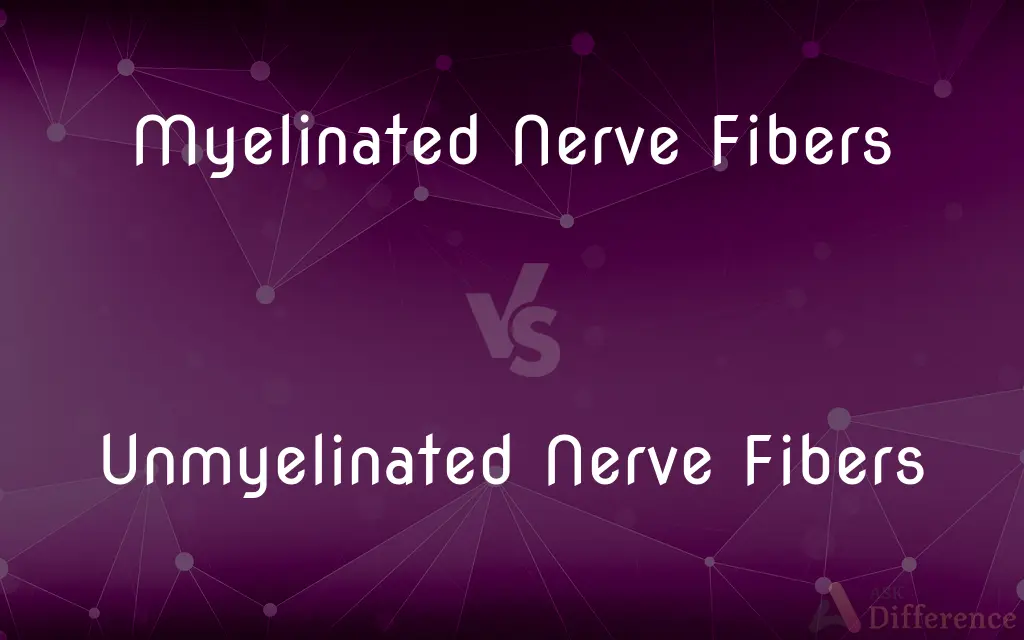Myelinated Nerve Fibers vs. Unmyelinated Nerve Fibers — What's the Difference?
Edited by Tayyaba Rehman — By Fiza Rafique — Published on December 23, 2023
Myelinated Nerve Fibers have a myelin sheath aiding rapid signal transmission, while Unmyelinated Nerve Fibers lack this sheath, resulting in slower transmission.

Difference Between Myelinated Nerve Fibers and Unmyelinated Nerve Fibers
Table of Contents
ADVERTISEMENT
Key Differences
Myelinated Nerve Fibers and Unmyelinated Nerve Fibers are both types of axons found in the nervous system. While Myelinated Nerve Fibers are surrounded by a myelin sheath, Unmyelinated Nerve Fibers are not.
This myelin sheath in Myelinated Nerve Fibers is a fatty substance that acts as an insulator. It helps speed up the transmission of nerve impulses. In contrast, the lack of myelin in Unmyelinated Nerve Fibers leads to slower nerve impulse conduction.
A unique feature of Myelinated Nerve Fibers is the presence of nodes of Ranvier. These are small gaps in the myelin sheath that further facilitate rapid signal transmission. Unmyelinated Nerve Fibers don't have these nodes, leading to continuous, slower conduction.
Myelinated Nerve Fibers are generally found in the white matter of the brain and spinal cord. They are crucial for tasks requiring swift responses, such as motor tasks. Unmyelinated Nerve Fibers, found in the gray matter, handle slower processes like temperature sensation.
The formation of myelin in Myelinated Nerve Fibers is a process known as myelination. This increases the efficiency of nerve transmission significantly. Unmyelinated Nerve Fibers, without this advantage, rely on other factors to transmit signals, albeit less efficiently.
ADVERTISEMENT
Comparison Chart
Presence of Myelin
Have a myelin sheath
Lack a myelin sheath
Signal Transmission Speed
Faster due to myelin insulation
Slower due to absence of myelin
Nodes of Ranvier
Present, facilitating rapid signal transmission
Absent, leading to continuous conduction
Location
Found primarily in white matter
Predominantly in gray matter
Main Functions
Swift responses, like motor tasks
Slower processes, e.g., temperature sensation
Compare with Definitions
Myelinated Nerve Fibers
Axons with a myelin sheath.
Myelinated Nerve Fibers enable faster transmission of nerve impulses.
Unmyelinated Nerve Fibers
Continuous signal conduction.
Signals in Unmyelinated Nerve Fibers don't jump between nodes as there are none.
Myelinated Nerve Fibers
Insulated by a fatty substance.
The myelin in Myelinated Nerve Fibers acts as a protective covering.
Unmyelinated Nerve Fibers
Axons without a myelin sheath.
Unmyelinated Nerve Fibers conduct signals at a slower pace.
Myelinated Nerve Fibers
Found in white matter.
White matter of the brain consists of Myelinated Nerve Fibers.
Unmyelinated Nerve Fibers
Lack fatty insulation.
The absence of myelin makes Unmyelinated Nerve Fibers vulnerable to interference.
Myelinated Nerve Fibers
Characterized by nodes of Ranvier.
The nodes of Ranvier in Myelinated Nerve Fibers facilitate rapid signaling.
Unmyelinated Nerve Fibers
Handle slower neural processes.
Unmyelinated Nerve Fibers are essential for sensations like temperature perception.
Myelinated Nerve Fibers
Essential for quick neural responses.
Motor tasks rely on the efficiency of Myelinated Nerve Fibers.
Unmyelinated Nerve Fibers
Located in gray matter.
The gray matter is predominantly composed of Unmyelinated Nerve Fibers.
Common Curiosities
Where are Myelinated Nerve Fibers predominantly located?
They are primarily found in the white matter of the brain and spinal cord.
What is the primary distinction between Myelinated Nerve Fibers and Unmyelinated Nerve Fibers?
Myelinated Nerve Fibers have a myelin sheath, whereas Unmyelinated Nerve Fibers don't.
How does myelin benefit Myelinated Nerve Fibers?
Myelin insulates the fiber, speeding up nerve impulse transmission.
Can a nerve fiber switch between being myelinated and unmyelinated?
No, but during development, some fibers undergo myelination.
Do both fiber types exist throughout the nervous system?
Yes, both Myelinated Nerve Fibers and Unmyelinated Nerve Fibers are present in the peripheral and central nervous systems.
Are nodes of Ranvier found in Unmyelinated Nerve Fibers?
No, they're characteristic of Myelinated Nerve Fibers.
How does myelination impact nerve function?
Myelination in Myelinated Nerve Fibers enhances efficiency and speed of nerve transmission.
Do Unmyelinated Nerve Fibers have any advantages over myelinated ones?
They're simpler in structure and might be more resilient in certain conditions.
Are all nerves either myelinated or unmyelinated?
Most nerves contain a mix of both types of fibers.
Why are nodes of Ranvier important in Myelinated Nerve Fibers?
They allow rapid, saltatory conduction of impulses.
Why do Unmyelinated Nerve Fibers transmit signals more slowly?
They lack the insulating myelin sheath, leading to slower conduction.
What happens if myelination doesn't occur correctly during development?
This can lead to developmental disorders and impaired neural function.
Why are Unmyelinated Nerve Fibers significant?
They handle slower processes like temperature sensation and certain pain signals.
How does damage to the myelin sheath affect function?
Damage can lead to disorders like multiple sclerosis, impairing the function of Myelinated Nerve Fibers.
Are Unmyelinated Nerve Fibers always slower than Myelinated Nerve Fibers?
Generally, yes, due to the absence of the myelin sheath.
Share Your Discovery

Previous Comparison
Upselling vs. Cross-Selling
Next Comparison
Unqualified Report vs. Qualified ReportAuthor Spotlight
Written by
Fiza RafiqueFiza Rafique is a skilled content writer at AskDifference.com, where she meticulously refines and enhances written pieces. Drawing from her vast editorial expertise, Fiza ensures clarity, accuracy, and precision in every article. Passionate about language, she continually seeks to elevate the quality of content for readers worldwide.
Edited by
Tayyaba RehmanTayyaba Rehman is a distinguished writer, currently serving as a primary contributor to askdifference.com. As a researcher in semantics and etymology, Tayyaba's passion for the complexity of languages and their distinctions has found a perfect home on the platform. Tayyaba delves into the intricacies of language, distinguishing between commonly confused words and phrases, thereby providing clarity for readers worldwide.
















































